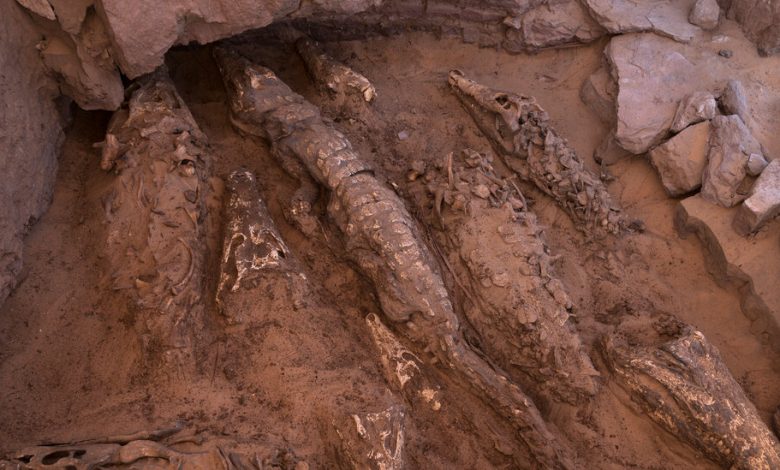10 Mummified Crocodiles Emerge From an Egyptian Tomb

At first glance, you may think you’re looking at a picture of living crocodiles moving stealthily through mud. But the animals above are mummies, possibly dead for more than 2,500 years and preserved in a ritual that likely honored Sobek, a fertility deity worshiped in ancient Egypt.
The mummies were among 10 adult crocodiles, likely from two different species, the remains of which were unearthed recently from a tomb at Qubbat al-Hawa on the west bank of the Nile River. The discovery was detailed in the journal PLoS ONE on Wednesday.
The crocodile has played an important role in Egyptian culture for thousands of years. In addition to being linked to a deity, it was a food source, and parts of the animal, like its fat, were used as medicine to treat body pains, stiffness and even balding.
Mummified animals, including ibises, cats and baboons, are relatively common finds in Egyptian tombs. Other mummified crocodile remains have been dug up, but most have been juveniles or hatchlings; additionally, the ones discovered in this new study were in great shape.
“Most of the time I’m dealing with fragments, with broken things,” said Bea De Cupere, an archaeozoologist at the Royal Belgian Institute of Natural Sciences and a co-author of the study. “To hear you have 10 crocodiles in a tomb. That’s special.”
She was called to the Qubbat al-Hawa site by a research team led by Alejandro Jiménez Serrano, an Egyptologist from the University of Jaén in Spain. In 2018, researchers uncovered seven small tombs under a Byzantium-era rubbish dump. In one of the tombs — sandwiched between the dump site and four human burials believed to be from around 2100 B.C. — were the mummified crocodiles.
Dr. De Cupere studies everything including bones, teeth and shells as well as coprolites, or fossilized feces, and animal prints. “You have archaeologists doing an excavation and, if they find animal remains that they think are worth looking at, that’s when we come into the picture,” Dr. De Cupere said.

The crocodiles emerged from a small tomb under a Byzantium-era rubbish dump. Video by Patricia Mora Riudavets and José Luis Pérez García.
Of the 10 mummified adult crocodile remains found, five were just heads and the other five were in varying states of completion, but one, at over seven feet long, was nearly complete. Often animal and human mummies are found wrapped in linen bandages secured by resin, which means scientists use techniques like CT scans or X-rays to see through the material. The Qubbat al-Hawa crocodiles contained no resin, and the only fragments of linen present had been all but entirely eaten by insects, allowing the researchers to study the mummies at the excavation site.
Based on skull shape and how the bony plates, or scutes, on the animals were arranged, the team hypothesized that the majority of crocodiles in the tomb appeared to be one species, Crocodylus suchus, while others were Crocodylus niloticus. Salima Ikram, an Egyptologist at the American University in Cairo who was not involved in the study, said that gathering this kind of information provided insight into ancient Egyptian understanding of the distinct behaviors of these two species and which the Egyptians would want to interact with, “because niloticus will eat you, whereas with suchus, you can conceivably swim in the same pool and live,” Dr. Ikram said.
A lack of resin also indicated that the crocodiles were probably mummified by being buried in the hot, sandy soil, where they dried out naturally before being entombed, which the researchers proposed happened before the Ptolemaic period, which lasted between 332 B.C. and 30 B.C.
“From the Ptolemaic period onward, they used huge quantities of resin,” Dr. De Cupere said.
The team hypothesized that the crocodile mummies were buried around the fifth century B.C., when animal mummification was increasingly popular in Egypt. But it will take radiocarbon dating to know for sure. The researchers hope that, in the near future, there will be a chance to perform such dating, as well as DNA analysis to verify the two species.
“The discovery of these mummies offers us new insights into ancient Egyptian religion and the treatment of these animals as an offering,” said Dr. Jiménez Serrano.
Dr. Ikram also views these discoveries as an important window into the relationship between people and the Qubbat al-Hawa necropolis, from the first burials over 4,000 years ago to the present day. “Within the community, how were these tombs viewed? What were their uses?” Dr. Ikram said. “You’re seeing how these tombs had after lives and lives.”